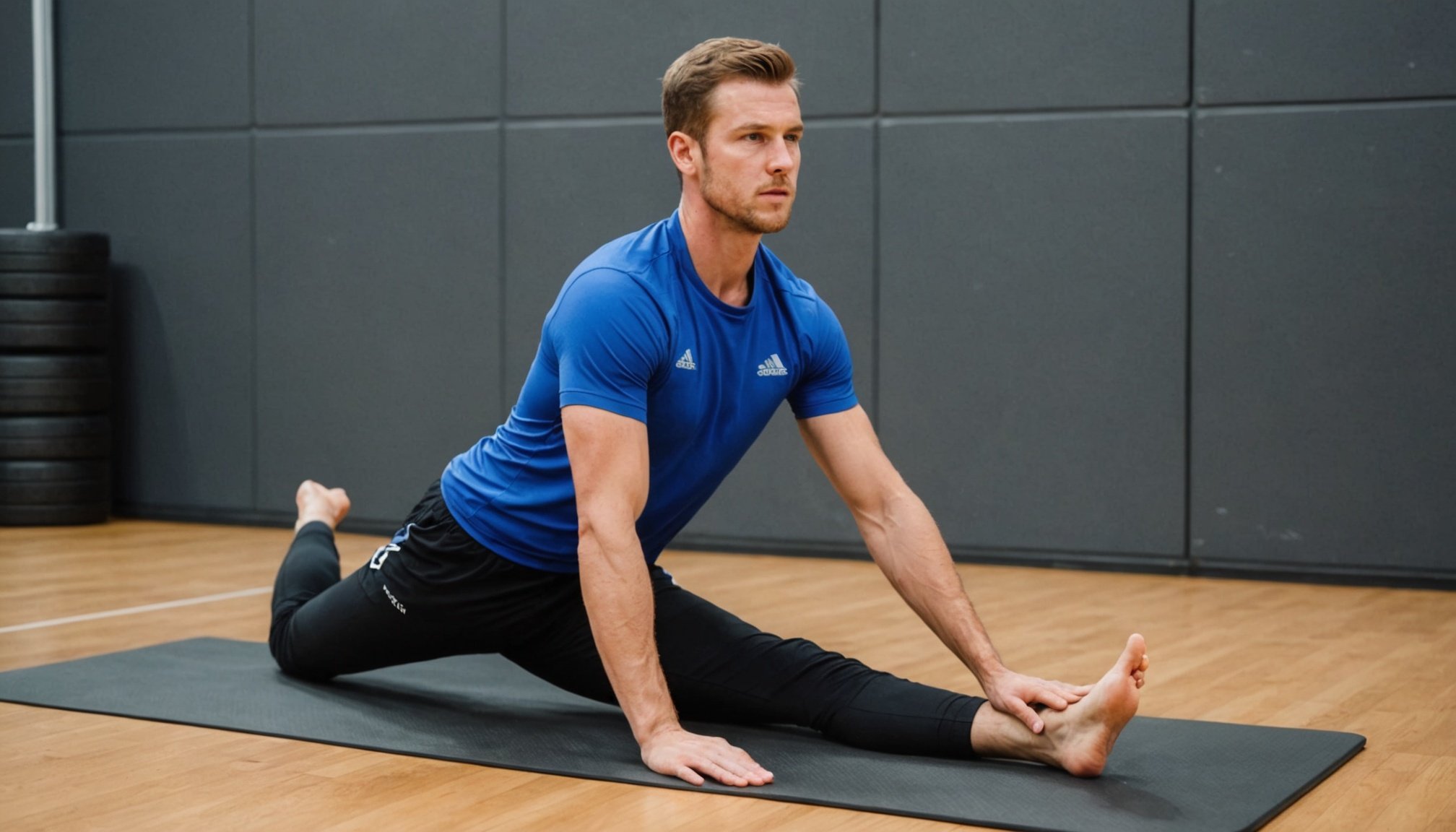Overview of Stretching Techniques for UK Athletes
Stretching is a crucial component of athletic training, directly contributing to injury prevention and enhanced athlete performance. The importance of incorporating stretching techniques into daily routines cannot be overstated, particularly for UK athletes who often compete in varying weather conditions and intense schedules.
Understanding the specific benefits for UK athletes, stretching can help maintain flexibility, improve circulation, and reduce muscle soreness. These benefits collectively lead to better performance and a reduced risk of injury. Coaches often emphasize the regular practice of stretching techniques to ensure athletes can perform at their peak effectively and safely.
Have you seen this : Mastering the Triathlon: Strategies for UK Athletes to Harmonize Training Across Three Disciplines for Peak Race Day Performance
Some common stretching methods include dynamic, static, and ballistic stretching. Dynamic stretching involves movement-based stretches that prepare the muscles for activity, making it ideal for warming up. Static stretching, where a muscle is extended and held in a position for a period, is recommended post-exercise to aid recovery. Ballistic stretching, which incorporates bouncing movements, should be performed carefully to avoid strain.
By integrating these stretching techniques, UK athletes can ensure more resilient performance and longevity in their athletic pursuits. It is recommended that athletes incorporate these stretches under professional guidance.
Additional reading : Enhancing Family-Friendly Experiences: Strategies for UK Sports Venues to Attract Family Audiences
Dynamic Stretching Techniques
Dynamic stretching is a crucial part of warm-up routines and pre-activity stretching. Unlike static stretching, it involves movement and muscle engagement. This type of stretching prepares muscles and joints for physical activity by mimicking the actions of the exercise.
Benefits of Dynamic Stretching
Incorporating dynamic stretching into a warm-up routine can enhance performance significantly. It helps increase blood flow to the muscles, improving both flexibility and range of motion. For athletes, this means improved agility and strength, while reducing the risk of injuries.
Examples of Dynamic Stretching
Some common dynamic stretching exercises include leg swings, arm circles, and walking lunges. These stretches are designed to “wake up” the muscle groups you plan to use during your main workout or sporting activity. They are excellent for pre-activity stretching.
Practical Tips for Implementation
- Start with low-intensity movements, gradually increasing as you progress.
- Focus on exercises that target the primary muscle groups involved in your activity.
- Avoid overextending joints; the goal is warming up not overstraining.
Integrating these techniques into your routine can ensure your body is optimally prepared for physical exertion, ultimately enhancing overall performance.
Static Stretching Techniques
Static stretching is crucial in enhancing flexibility and plays a significant role in athletes’ recovery routines. This method involves stretching a muscle to its farthest point and holding the position for a period, typically between 15 to 60 seconds. Athletes across the UK often incorporate static stretching post-activity to reduce muscle tension and enhance recovery.
Benefits include improved flexibility, decreased muscle stiffness, and enhanced blood circulation. For UK athletes, integrating static stretching after sports activities can help reduce the risk of injuries and pave the way for improved performance.
Guidelines for executing static stretching safely involve:
- Ensuring that the muscles are warm before starting, often through a mild warm-up to prevent overstretching.
- Holding each stretch steadily without bouncing, which can lead to injury.
- Breathing deeply and consistently to facilitate relaxation and effectiveness.
Avoid straining or pushing too hard beyond comfort. Flexibility improves gradually, so consistent practice is key. Static stretching should be viewed as a necessary component of athletic recovery routines, fostering long-term physical health and sportsmanship. Encouragingly, understanding these techniques will empower athletes to make informed choices in their training regimes.
Proprioceptive Neuromuscular Facilitation (PNF)
Proprioceptive Neuromuscular Facilitation (PNF) stretching is an advanced technique designed to enhance muscle flexibility and recovery. This approach involves a sequence of stretch and contraction cycles, intended to increase the muscle’s range of motion. PNF stretching operates on the principle of autogenic or reciprocal inhibition—the relaxation of muscles during a reflex contraction of the opposite muscle. This technique is commonly employed to complement muscle recovery post-exercise, particularly for athletes seeking to improve performance and prevent injuries.
Prominent studies highlight the effectiveness of PNF techniques. Research suggests that PNF stretching significantly increases flexibility, more so than static or dynamic stretching alone, making it ideal for athletes requiring extensive muscle range. This method is notably suited for sports demanding high flexibility, such as gymnastics, dance, and athletics.
Ideal situations for implementing PNF stretching include post-workout cool-down protocols or rehabilitation exercises targeting specific muscle groups. While PNF is beneficial, it’s crucial to incorporate it cautiously under professional guidance to avoid potential overexertion or injury. Professional oversight ensures that the advanced techniques of PNF are safely and effectively employed to optimize muscle recovery and flexibility.
Stretching for Specific Sports
Customising stretching routines to align with sport-specific needs is essential for optimising performance and minimising injury among athletes. Different athletic disciplines have unique requirements, and employing tailored techniques can significantly enhance an athlete’s capabilities.
For instance, tailored techniques are crucial in disciplines like gymnastics, where flexibility is crucial. Here, incorporating dynamic stretches targeting hip flexibility and shoulder mobility can be beneficial. Whereas in sports such as basketball, stretching routines should focus on lower body strength, and agility with exercises like hamstring and calf stretches play a critical role.
Teams and individuals benefit from adopting sport-specific stretching routines. In football, pre-match dynamic stretching can increase heart rate and power output, preparing players for sudden bursts of speed and strength. Individual sports, like swimming, require routines that enhance shoulder flexibility and core strength, as these are pivotal in executing effective strokes.
Case studies have shown that athletes who engage in tailored stretching report fewer injuries. For example, runners who regularly perform calf and quadriceps stretches experience fewer muscle strains. By aligning stretching routines with the specific demands of each sport, athletes can significantly improve their performance while reducing injury risks.
Expert Opinions on Stretching Techniques
Seeking expert advice can significantly elevate an athlete’s performance levels. Physiotherapists and sports scientists emphasize the importance of stretching in improving flexibility and reducing injury risks. According to a sports scientist, stretching should be integrated into daily routines for optimal results. Whether you’re a professional athlete or a sports enthusiast, understanding the nuances of different techniques is essential.
Physiotherapists’ Insights
Physiotherapists often recommend dynamic stretching before activities to activate muscles and increase blood flow. These movements mimic the exercises you’ll perform, thus preparing the body effectively. In contrast, static stretching is best done post-exercise when your muscles are warm.
Testimonials from UK Athletes
Many successful UK athletes have embraced these strategies. For example, Olympic sprinters often prefer a combination of these strategies based on expert recommendations, allowing them to perform at their peak while minimizing injuries.
Traditional vs. Modern Techniques
When considering traditional versus modern stretching approaches, modern techniques often include a performance enhancement element. This includes techniques such as proprioceptive neuromuscular facilitation, which combines stretching with contraction phases. While traditional techniques have their place, incorporating modern, researched-based methods could offer athletes better performance outcomes.
Common Mistakes in Stretching
Many individuals unknowingly commit stretching errors that can lead to more harm than good. One of the most frequent mistakes is overstretching, which can cause muscle damage. It often occurs when people push themselves beyond their limits, ignoring their body’s signals. Another common error is skipping the warm-up before stretching. This oversight results in colder, less pliable muscles, increasing the likelihood of injury risks.
Improper technique, such as bouncing during static stretches, also poses significant risks. This jerky motion, often mistaken for dynamic stretching, can lead to strains. Stretching inconsistently or failing to integrate a balanced routine can lead to muscle imbalances and potential injury.
To mitigate these risks, adhering to best practices is essential. Begin each session with a moderate warm-up to prepare muscles for stretching. Focus on slow, deliberate movements that respect the body’s natural limits. Maintain proper form to ensure effectiveness and safety. Consistency is key; integrate stretching into your regular fitness regimen for balanced results. Remember, the goal is flexibility and injury prevention, not pushing through pain. Listen to your body and modify stretches as needed to enjoy a safer and more productive experience.
Future Trends in Stretching Techniques
Innovative stretching techniques continue to shape the future of athletic training. As the understanding of body dynamics evolves, recent research is focusing on personalized stretching regimens tailored to individual needs. This approach maximizes effectiveness and reduces injury risk, a significant advancement for professional and amateur athletes alike.
Technological Advancements
The integration of technology in stretching is revolutionizing the field. Wearable devices are now being used to monitor muscle flexibility in real-time, allowing for adjustments to ensure optimal stretching. Additionally, new apps provide guided stretching routines using AI to analyze user performance and recommend workouts that focus on areas needing improvement. These tools are helping coaches and athletes adopt cutting-edge techniques efficiently.
Future Predictions
Looking ahead, athletic training advancements will likely involve a blend of AI-driven insights and biomechanics research. This fusion could lead to safer, more efficient conditioning programs, enhancing performance while preventing injuries. Virtual reality (VR) could also play a role, offering immersive environments where athletes practice movements with instant, adaptive feedback. Such futuristic methods promise to redefine how flexibility and strength training are approached in sports worldwide.











